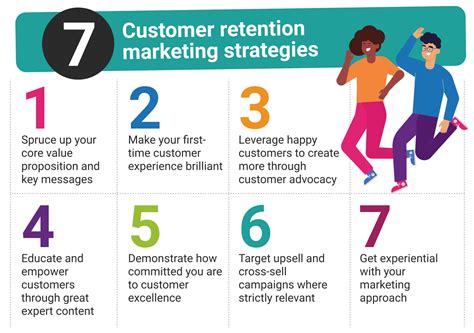Customer Retention Strategies for Small Businesses

Maximize customer retention with expert strategies. Analyze behavior, implement loyalty programs, personalize communications, and measure success. Actionable insights for businesses.In today’s competitive market, small businesses are constantly seeking ways to not only attract new customers but also to retain their existing ones. Customer retention is vital for the long-term success and growth of any business, as it is often more cost-effective to retain a customer than to acquire a new one. In this blog post, we will delve into the various strategies that small businesses can implement to improve customer retention. From understanding the importance of customer retention to analyzing customer behavior and implementing loyalty programs, we will explore the key steps that businesses can take to keep their customers coming back for more. Additionally, we will discuss the significance of personalizing customer communications and the various metrics that businesses can use to measure the success of their retention efforts. By the end of this post, you will have a comprehensive understanding of the strategies that can help your small business effectively retain its customer base.
Understanding Customer Retention
Customer retention is the process of keeping existing customers engaged and loyal to your brand. It involves understanding the factors that influence customers to continue doing business with a company and implementing strategies to foster long-term relationships. Effective customer retention is essential for the success of small businesses, as it can lead to increased revenue and sustainable growth.
One key component of understanding customer retention is analyzing customer behavior. By tracking and interpreting customer data, small businesses can gain valuable insights into the preferences and buying habits of their customers. This information can be used to tailor products and services to meet the specific needs of the target audience, ultimately increasing customer satisfaction and loyalty.
Implementing loyalty programs is another important strategy for customer retention. By offering incentives, rewards, and exclusive benefits to repeat customers, small businesses can create a sense of value and appreciation, encouraging customers to continue doing business with them. Loyalty programs can also help to differentiate a business from competitors, as customers are more likely to stick with a company that offers them additional perks and recognition.
Analyzing Customer Behavior
When it comes to running a small business, understanding customer behavior is crucial for success. By analyzing and interpreting customer behavior, business owners can gain valuable insights into their customers’ preferences, habits, and needs. This information can then be used to improve products and services, personalize marketing strategies, and build strong customer relationships.
One of the most effective ways to analyze customer behavior is through the use of data and analytics. By tracking and measuring customer interactions, businesses can identify patterns, trends, and areas for improvement. This data can be collected from various sources, such as website traffic, social media engagement, and customer feedback, and then used to make informed business decisions.
In addition to data analysis, small businesses can also benefit from conducting customer surveys and interviews. By directly engaging with customers, business owners can gain a deeper understanding of their needs and preferences. This hands-on approach can provide valuable qualitative insights that are not always captured through traditional data analysis methods.
Implementing Loyalty Programs
Implementing loyalty programs is a crucial aspect of retaining customers for small businesses. By rewarding customers for their repeat business, businesses can build strong relationships and encourage them to continue choosing their brand over competitors. These programs can come in the form of points systems, exclusive discounts, or free products or services after a certain number of purchases.
When implementing loyalty programs, it’s important for small businesses to understand the needs and preferences of their customer base. This may involve collecting data on purchasing habits and preferences through a customer relationship management (CRM) system, and using this data to tailor loyalty program offerings to best meet the needs of the customer base.
Additionally, loyalty programs can be integrated with digital platforms and marketing efforts to communicate the benefits and rewards of the program to existing and potential customers. This can help to drive awareness and participation in the loyalty program, ultimately leading to increased customer retention and satisfaction.
Personalizing Customer Communications
Personalizing customer communications is an essential aspect of any small business’s customer retention strategy. By personalizing communications, businesses can show their customers that they are valued and understood, leading to a stronger bond with the brand. When customers receive personalized messages, they are more likely to feel a sense of connection and loyalty to the business, which in turn increases the likelihood of them staying engaged and making repeat purchases.
One way to personalize customer communications is through the use of customer data. By analyzing customer behavior and preferences, small businesses can tailor their messages to fit the individual needs and interests of each customer. This can be done through targeted email marketing, personalized product recommendations, or even customizing the content on the company’s website to match the customer’s previous interactions with the brand.
It is also important for small businesses to utilize loyalty programs as a means of personalizing customer communications. By offering rewards and incentives based on a customer’s purchase history and behavior, businesses can make their customers feel appreciated and recognized. This not only encourages repeat business, but it also fosters a sense of exclusivity and special treatment for loyal customers, further strengthening the customer-business relationship.
Measuring Retention Success
Measuring retention success is a critical aspect of any business, especially for small businesses that rely heavily on building customer loyalty. It involves tracking and analyzing the effectiveness of your customer retention strategies to ensure that your efforts are yielding positive results.
One key metric for measuring retention success is the customer retention rate, which is calculated by dividing the number of customers at the end of a period by the total number of customers at the beginning of that period, and then multiplying by 100. A high retention rate indicates that your customers are satisfied and loyal to your business, while a low retention rate may signal issues that need to be addressed.
Additionally, analyzing customer feedback and survey data can provide valuable insights into customer satisfaction and loyalty. By gathering and interpreting this data, you can identify areas for improvement and make necessary adjustments to your retention strategies. It’s important to continuously monitor and measure retention success in order to adapt to changing customer behaviors and preferences, and to ensure the long-term growth and sustainability of your business.





